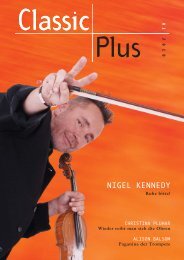Libretto & Synopsis - EMI Classics
Libretto & Synopsis - EMI Classics
Libretto & Synopsis - EMI Classics
Erfolgreiche ePaper selbst erstellen
Machen Sie aus Ihren PDF Publikationen ein blätterbares Flipbook mit unserer einzigartigen Google optimierten e-Paper Software.
SYNOPSIS<br />
In the ‘third day’ of his ‘stage festival’, Wagner was able to deploy the new skills in word-setting, orchestration and use of<br />
leitmotifs that he had acquired while writing Tristan und Isolde and Die Meistersinger von Nürnberg in between the composition of<br />
Acts II and III of Siegfried. One has only to compare his use of relatively basic, short, identikit leitmotifs in Das Rheingold (the<br />
giants’ music) with their lengthier, better integrated successors in Götterdämmerung. Here the fabric of the score itself seems to<br />
have been eaten into by the falling phrase of Alberich’s curse, while the richly intertwining and contrapuntal displays of passages<br />
like Siegfried’s Rhine Journey, Siegfried’s arrival at the Gibichung Hall or the extraordinary intervals of Brünnhilde’s outbursts of<br />
rage in Act II (the orchestra seeming to leap from Weber’s Wolf’s Glen to Strauss’s Elektra in a matter of bars) testify to a greatly<br />
increased range of colour, tonality and musico-dramatic effects. In addition to these ‘new’ developments, Wagner makes clever<br />
use of ‘old’ effects – some duets are allowed (the blood-brotherhood oath) and even a full-blooded chorus (Hagen’s vassals).<br />
These do not represent, as Bernard Shaw famously complained, a sell-out to grand operatic tradition but rather Wagner’s<br />
deliberate use of older, conventional musical forms to depict older, conventional people.<br />
Compact Disc 1<br />
PROLOGUE<br />
The same scene as at the end of the second day, on the Valkyries’ rock.<br />
The Norns are the Northern Fates, unnamed by Wagner, but in the sagas called Urd, or Wurd (like the ‘weird’ sisters in Macbeth),<br />
representing the past, Verdandi the present, and Skuld the future. Wagner looked to imitate the dry, enigmatic speech-patterns of<br />
the Poetic Edda’s Völuspá (‘The Wise Woman’s Prophesy’) – ‘Much description of wisdom have the three maidens/who came from<br />
the waters close to that tree/They established laws, decided the lives/men were to lead, marked out their fates’. The orchestral<br />
prelude [1] recalls the awakening of Brünnhilde on her rock surrounded by fire, Erda (whose daughters the Norns are), Nature<br />
(from which the Norns have come) and the annunciation of death. Taking turns, the Norns relate the events of the world to date<br />
and to come, with especial emphasis on the fate (and decisions) of Wotan. They also continue to spin the thread of destiny [2],<br />
though they are losing knowledge and are not even sure whether the growing light they can see is dawn, or Loge’s fire that surrounds<br />
Brünnhilde’s rock. As night wanes [3], their vision fades completely – Alberich’s curse on the ring gnaws at their rope. It<br />
breaks. They abandon their prophetic role and return to their mother Erda.<br />
2





